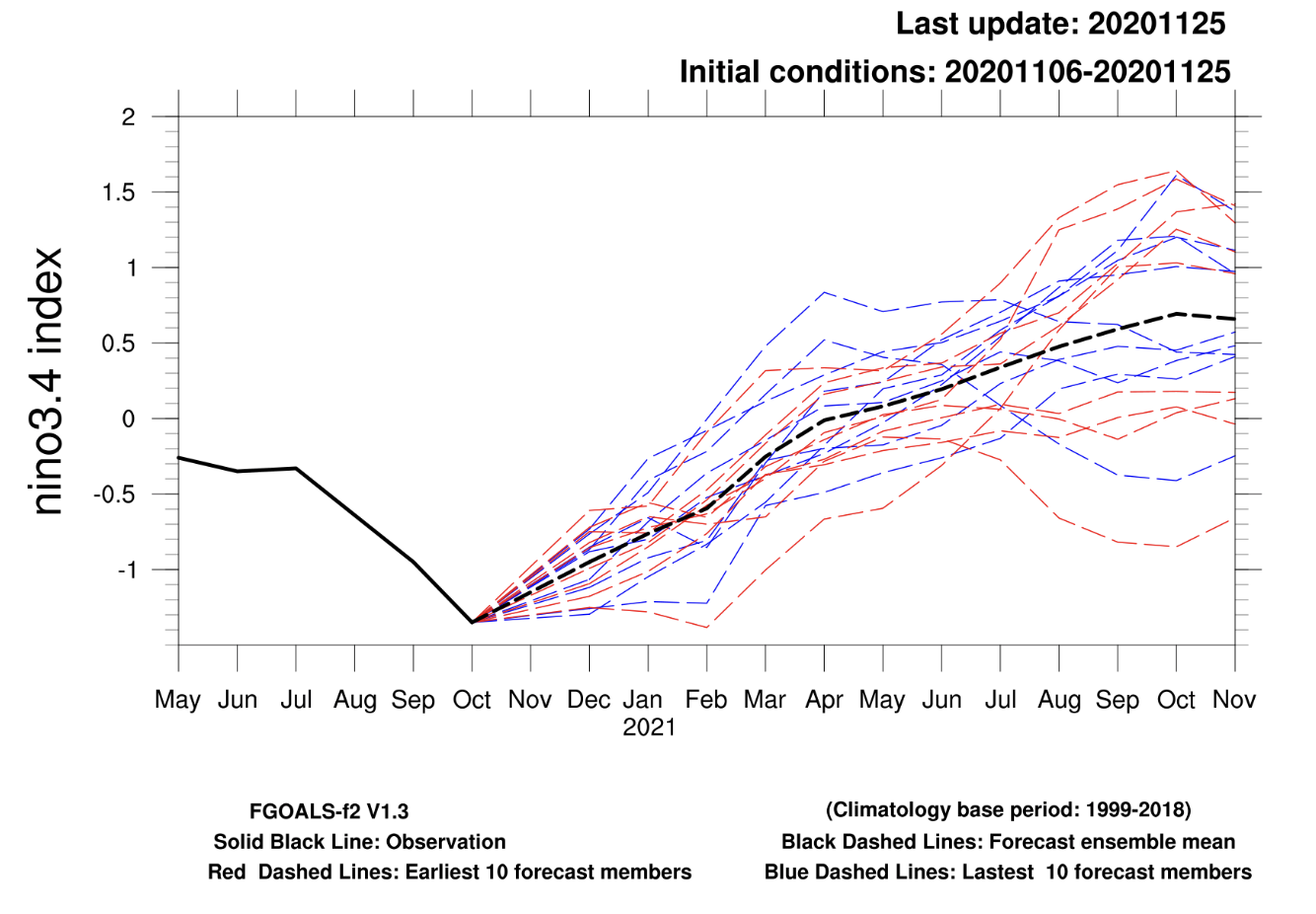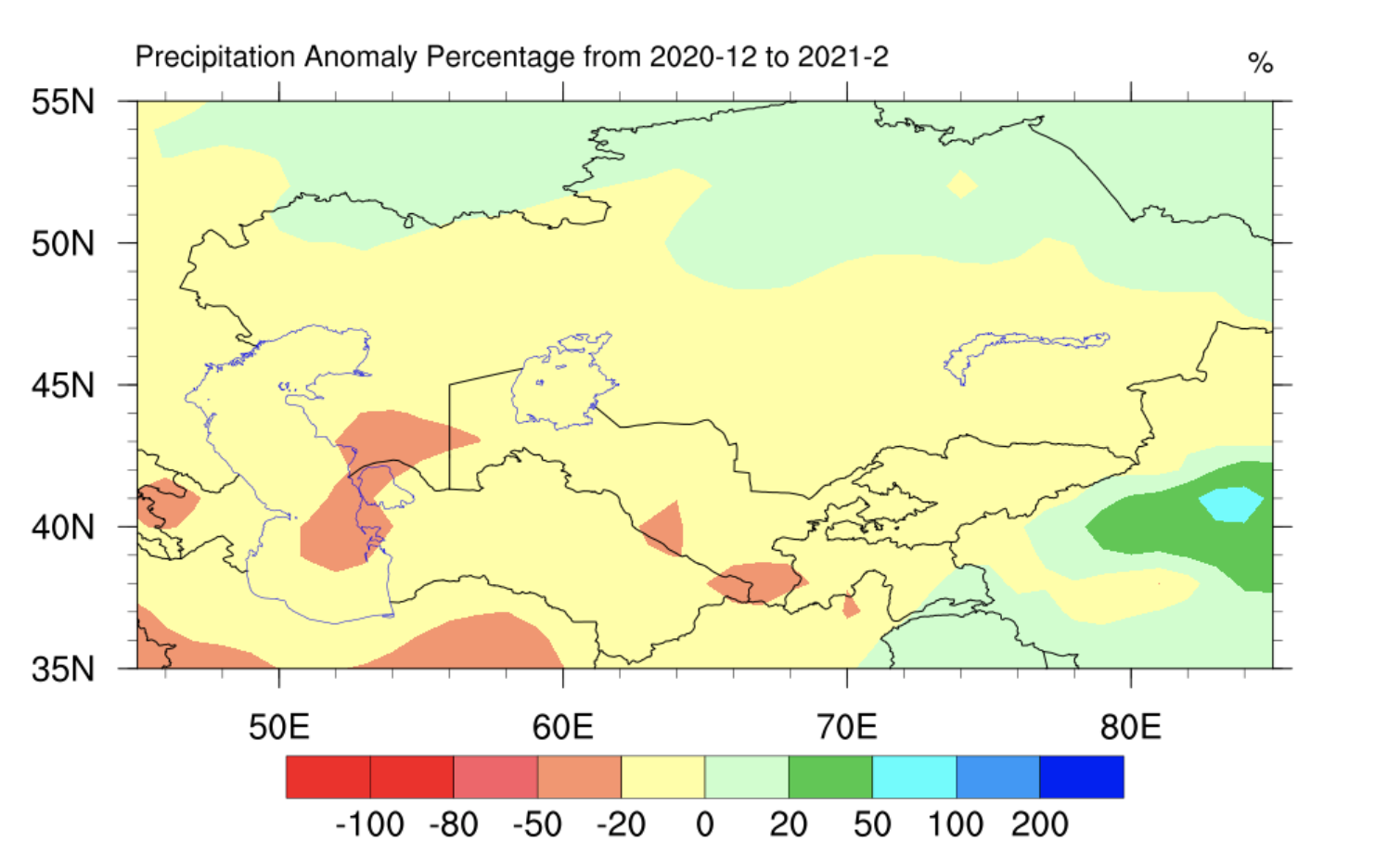The latest seasonal prediction was updated by the ANSO-MISSPAD team on Nov 25, 2020. The temperature is predicted to be warmer than normal in the winter of 2020 (December, January, and February), while it’s colder than normal by 0.5~1.0.℃ in early winter (December) and above normal in late winter (February). Particularly in the northern Central Asia, the temperature anomaly can be more than 2.0.℃ in Kazakhstan. Central Asia will have less rainfall than usual in most regions. In the western and eastern regions, the rainfall is about 20~30% less.
It should be noted that, the northern part of Central Asia shows different trends from that of the southern part, a distinct north-south seasaw pattern. The prediction is based on FGOALS-f2, which is a real-time weather and sub-seasonal to seasonal(S2S) prediction system, developed by the Institute of Atmospheric Physics, Chinese Academy of Sciences (IAP/CAS). FGOALS is now a member of S2S Project of the World Weather Research Programme (WWRP) and World Climate Research Programme (WCRP).
1. Less rainfall is predicted in most Central Asia
The seasonal forecast was updated in November 2020. It indicates that the sea surface temperature (SST) anomaly in the central and eastern equatorial Pacific will drop to negative in the winter of 2020 (December, January, and February), leading to a weak La Nina episode (Figure 1). According to the empirical statistical relationship, La Nina events usually result in less winter precipitation in Central Asia. This statistical relationship is confirmed by the numerical model simulation, which shows less-than-normal precipitation in Central Asia (Figure 2).
Figure 1. The ANSO-MISSPAD seasonal prediction suggests cooling in the central tropical Pacific towards a La Nina event. La Nina events typically reduce winter rainfall in central Asia.
Figure 2. The winter (DJF) precipitation anomaly percentage (%) predicted by the FGOALS-f2 Sub-seasonal-to-seasonal Prediction System of ANSO MISSPAD for the winter of 2020.
According to the latest seasonal forecast, the Central Asian region will have less precipitation in the winter of 2020 (December, January, and February), mainly in Kazakhstan, Uzbekistan, and Turkmenistan. The percentage of precipitation anomaly in this region reaches -20%, indicating a shortage of water resources in this region.
Figure 3. The winter (DJF) 500hPa geopotential height anomaly (units: gpm) predicted by the FGOALS-f2 Subseasonal-to-Seasonal Prediction System of ANSO MISSPAD for the winter of 2020.
The lack of precipitation in Central Asia is related to the intensified high-pressure ridge of the middle latitude westerly circulation (Figure 3). The 500hPa geopotential height has a positive anomaly center over the Ural Mountains, conducive to the formation of sinking anomalies in Central Asia. The low-level easterly anomaly on the west side of the Pamirs Plateau tends to cause airflow divergence of the westerly belt, which leads to a decrease in precipitation.
2. The overall winter temperature is slightly higher than normal, while coder in early winter and warmer in late winter.
According to the ANSO MISSPAD S2S prediction system, the overall winter temperature in Central Asia will be slightly higher than normal. In northern Kazakhstan, the winter temperature will be >2.0 ℃ higher than normal. In early winter (December), the temperature in most areas was about 0.5~1.0℃ lower than usual. While in late winter (February), the temperature in Central Asia will be about 2.0℃ higher than usual, especially in the northern part.
Figure 4. The winter (DJF) temperature anomaly percentage (℃) predicted by the FGOALS-f2 Sub-seasonal-to-seasonal Prediction System of ANSO-MISSPAD for the winter of 2020.
Copywriter: Ke Wei
Review: Qing Bao
Picture: Lei Wang




